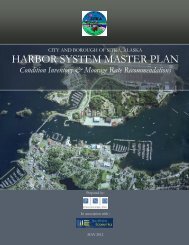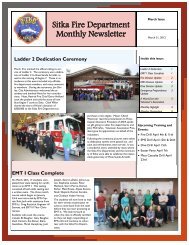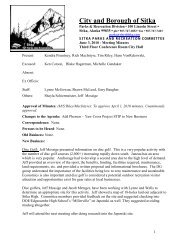final Sedimentation Report - City and Borough of Sitka
final Sedimentation Report - City and Borough of Sitka
final Sedimentation Report - City and Borough of Sitka
You also want an ePaper? Increase the reach of your titles
YUMPU automatically turns print PDFs into web optimized ePapers that Google loves.
Comment<br />
Number Comment Summary Response <strong>and</strong> <strong>Report</strong> Location<br />
USFS 3 Comment on use <strong>of</strong> daily The hydraulic <strong>and</strong> sediment transport<br />
average flows <strong>and</strong> need to use calculations were made for median daily<br />
peak flows.<br />
flows during the spawning periods to<br />
provide information about water width <strong>and</strong><br />
depth during normal spawning conditions.<br />
Peak flows do indeed shape the channel<br />
configuration. It is assumed that the cross<br />
sections measured in the existing delta (<strong>and</strong><br />
used in the hydraulic analysis) are<br />
representative <strong>of</strong> a future delta channel<br />
formed under a range <strong>of</strong> low, median, <strong>and</strong><br />
peak flows.<br />
USFS 4 Stream gradient contradictions. The delta channel gradients listed in Table 3<br />
(page 19) is the local gradient surveyed at<br />
those three particular delta cross sections<br />
which are located on the steeper part <strong>of</strong> the<br />
existing delta (see Figure 10). The<br />
Assumption 3 range <strong>of</strong> delta gradients (page<br />
14) was used in the XSPRO analysis to<br />
represent the gradient <strong>of</strong> the future<br />
(expansion) delta since the expansion delta<br />
will be constructed in a lower-gradient<br />
valley than the existing delta (again see<br />
Figure 10). [The gradient for Reach 3 in<br />
Table 11 <strong>of</strong> the Fisheries <strong>Report</strong> was<br />
incorrectly listed as 0.1 percent – this has<br />
been corrected in that report.]<br />
USFS 5 Comment on Figure 7 <strong>and</strong> The predicted lower end <strong>of</strong> the delta was<br />
predicted extent <strong>of</strong> new (post- graded to the maximum drawdown<br />
Expansion) delta.<br />
elevation under expansion conditions which<br />
is above the lower barrier falls (similar to<br />
how the existing delta is graded to the<br />
current maximum drawdown elevation<br />
based on the topographic surveys – See<br />
Figure 10). There would be some<br />
deposition below the maximum drawdown<br />
elevation, but we do not have any<br />
information on the current extent <strong>of</strong> these<br />
deposits (either volume or extent), so they<br />
were not included in either the current or<br />
future analysis.<br />
Blue Lake Reservoir <strong>Sedimentation</strong> <strong>Report</strong> 32 Blue Lake Project Expansion<br />
Watershed GeoDynamics FERC No. 2230<br />
December 2009








